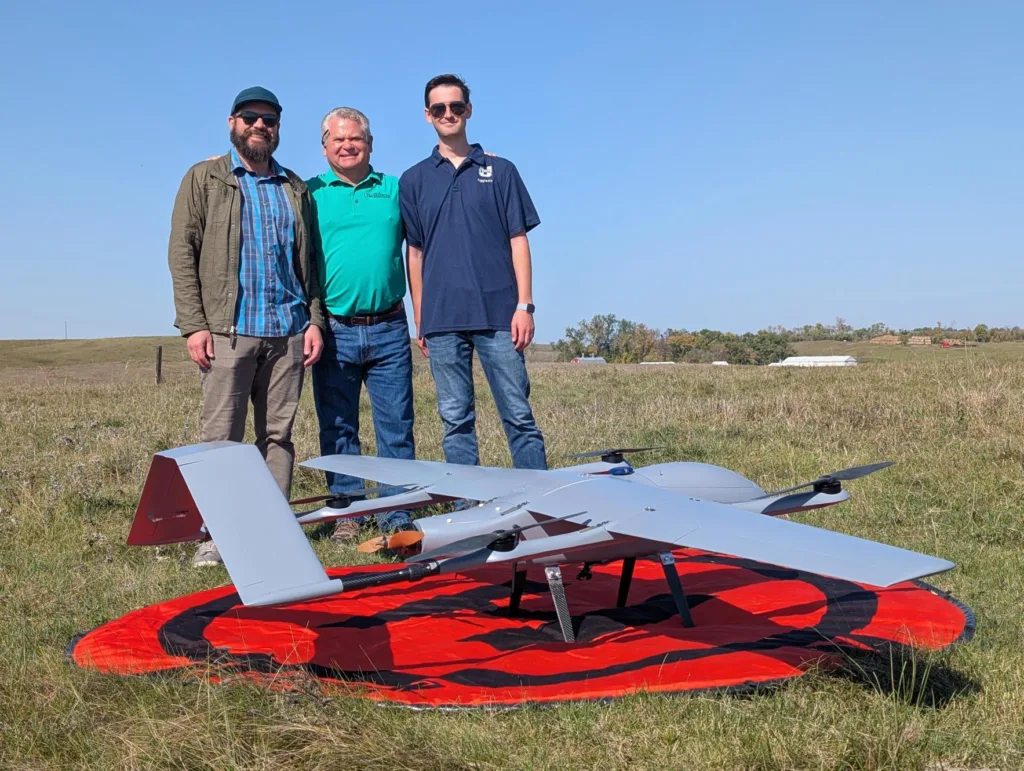Project RuralReach, an initiative designed to use drones to dramatically improve rural life, successfully completes second use-case test

GRAND FORKS — The UND Center for Innovation is proud to announce the successful completion of the second use-case test for Project RuralReach, regarding the use of UAS innovations and sustainable power.
The flight operations took place on Sept. 29 in collaboration with Botlink (a drone-control hardware and software company), Utah State University’s AggieAir and Dunlevy Consulting. The team carried out two flights, each covering 53 nautical miles with approximately 63 minutes of airtime — surpassing the project goals of achieving electric vehicle (EV) flights beyond 40 minutes and more than 50 miles in distance.
The aircraft used for this test was the ANGEL 1-BE, a small, fully electric vertical take-off and landing (VTOL) platform designed and built by extended-range, sustainable operations — including the internal electrical configuration, which was altered by AggieAir specifically for the endurance mission. The test took place in the southeast region of North Dakota, and was designed to explore sustainable power opportunities and environmental conditions to extend the operational range of autonomous vehicles.
“Botlink CEO Terri Zimmerman’s leadership in North Dakota UAS has been great to watch, and our organization was pleased to partner with Botlink and Badland Batteries as we demonstrated endurance missions with North Dakotan UAS and North Dakotan energy storage systems,” said Matt Dunlevy of Dunlevy Consulting.
“Working with Amy Whitney and Jeff Barta of the UND Center for Innovation was also fantastic, as always. The success of this mission underscores North Dakota’s growing capability to lead the nation in energy-resilient aerospace operations.
“It also validates the strength of collaboration between industry and academia in advancing homegrown innovation that can compete globally.”
A significant step forward
Powering the ANGEL 1-BE were four Badland Batteries 6S 17000-milliamp batteries, which are Packet Digital’s first off-the-shelf battery packs. Badland Batteries are designed, assembled, shipped and supported from Fargo, N.D., where Packet Digital is located. For purchase information, visit badlandbatteries.com/store.
Also onboard the ANGEL 1-BE was the Botlink XRD2, which maintained cellular connectivity over the Verizon cell network for the entire flight, streaming telemetry and video data with the ability to transmit telemetry data to UTM or Unmanned Traffic Management suppliers, such as North Dakota’s Vantis network’s API.
The Botlink XRD2 is compatible worldwide and ready to ship. For purchase information, visit botlink.com/xrd2.
“This was a great success for Badland Batteries and Botlink,” Botlink General Manager Matt Sather said. “This project showcases the impact drones can have in rural environments. Being able to use North Dakota-made batteries and cellular connectivity throughout highlights the incredible things going on in our state across the UAS industry.”
Funded through the U.S. Economic Development Administration’s ARPA Economic Adjustment Assistance Program, Project RuralReach continues to explore innovative ways to enhance connectivity, efficiency, and sustainability in remote regions. With this successful test, the project moves another step closer to scalable, real-world applications that can serve rural industries and communities.
Media Contact
Haylee Bjork, Marketing Outreach Coordinator
Organization: UND Center for Innovation
Email: haylee.bjork@und.edu
Phone: 701.777.3281

